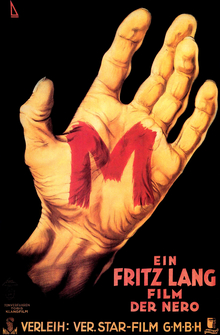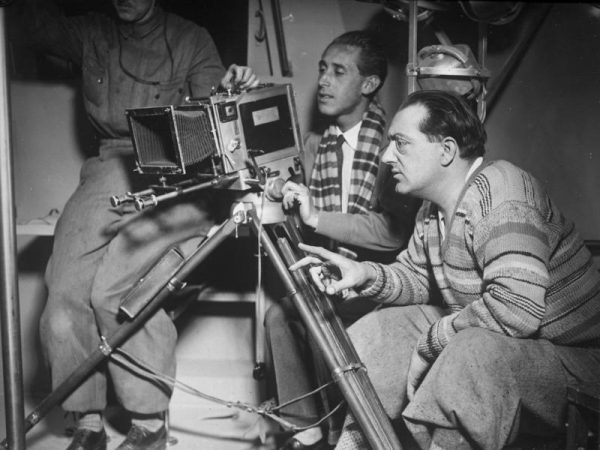
M – A city looks for a murderer, Theatrical Release Poster (1931)
On May 11, 1931, German drama-thriller “M – A city looks for a murderer” directed by Fritz Lang and starring Peter Lorre premiered in Berlin at the UFA-Palast am Zoo. Now considered a classic, the film was deemed by Fritz Lang to be his finest work. M was ranked at number thirty-three in Empire magazines’ “The 100 Best Films Of World Cinema” in 2010. The film concerns both the actions of a serial killer of children, and the manhunt for him, conducted by both the police and the criminal underworld.
“Gradually, and at times reluctantly, I have come to the conclusion that every human mind harbors a latent compulsion to murder.”
– Fritz Lang, Why I am interested in Murder. New York, 1947
Fritz Lang and the German School of Expressionism
Austrian-German filmmaker, screenwriter, and occasional film producer and actor Fritz Lang is one of the best-known émigrés from Germany’s school of Expressionism. His most famous films include the groundbreaking futuristic Metropolis [1] (1927) and the also influential M from 1931, a film noir precursor that he made before he moved to the United States. In this first phase of his career, Lang combined popular genres with Expressionist techniques to create an unprecedented synthesis of popular entertainment with art cinema. Together with his wife, the writer and actress Thea von Harbou, he co-wrote all of his movies from 1921 through 1933, including Dr. Mabuse, der Spieler (Dr. Mabuse the Gambler; 1922), which ran for over four hours in two parts in the original version, the five-hour Die Nibelungen (1924), the famous 1927 film Metropolis, the science fiction film Woman in the Moon (1929), and the 1931 classic, M, his first “talking” picture that we feature today.
The Disturbing Story of a Child Murderer
Considered by many film scholars to be his masterpiece, M is a disturbing story of a child murderer played by Peter Lorre in his first starring role, who is hunted down and brought to rough justice by Berlin’s criminal underworld. Lang placed an advert in a newspaper in 1930 stating that his next film would be Mörder unter uns (Murderer Among Us) and that it was about a child murderer. He immediately began receiving threatening letters in the mail and was also denied a studio space to shoot the film at the Staaken Studios. Lang was even being denied access to the studio since the Nazi party suspected that the film was meant to depict the Nazis, but this issue could soon be resolved and the production started.
The Story of M
The story plays in Berlin in the early 1930’s. Within the term of a year, 8 children have been lured to their death by a psychopathic killer. The police have redoubled their efforts to find the murderer but have yet to find him and citizens are beginning to dispense their own justice on otherwise innocent people. The heads of the city’s criminal element are paying a high price due to the increased police presence and so they decide to find the psychopath on their own. With the help of the beggars union they float the city with a net of spies. Finally they succeed to find the killer and put him on trial in their own special court but also the police has made progress while pursuing their own views on how justice should be administered.[2]
Creating a New Genre
Created with a passion for detail, M is considered a successful transitional film from the silents to the talkies, taking into its mise en scene the best of both those worlds. It is often considered the greatest of all the serial killer films made, even if it is mistakeningly considered by some, now, as merely a museum piece. The depth of its storytelling can easily be compared with the greatest films of that genre such as Psycho and The Silence of the Lambs.[3]
Real Criminals as Extras
M was eventually shot in six weeks at a Staaken Zeppelinhalle studio, just outside Berlin. While researching for the film, Lang spent eight days inside a mental institution in Germany and met several child murderers. He used several real criminals as extras in the film and eventually 25 cast members were arrested during the film’s shooting. Lang did not show any acts of violence or deaths of children on screen and later said that by only suggesting violence he forced “each individual member of the audience to create the gruesome details of the murder according to his personal imagination“.

Fritz Lang while shooting “The Woman in the Moon”
Finding a Leitmotif
M was Lang’s first sound film and Lang experimented with the new technology. It has a dense and complex soundtrack, as opposed to the more theatrical “talkies” being released at the time. The soundtrack includes a narrator, sounds occurring off-camera, sounds motivating action and suspenseful moments of silence before sudden noise. The film was one of the first to use a leitmotif, a technique borrowed from opera, associating a tune with Lorre’s character, who whistles the tune “In the Hall of the Mountain King” from Edvard Grieg‘s Peer Gynt Suite No. 1. Later in the film, the mere sound of the song lets the audience know that he is nearby, off-screen.
The Premiere
M premiered in Berlin on 11 May 1931 at the UFA-Palast am Zoo in a version lasting 117 minutes. M was later released in the U.S. in 1933 by Foremco Pictures. After playing in German with English subtitles for two weeks, it was pulled from theaters and replaced by an English version.
The Stereotype of the Tyrannical German Film Director
Lang, who was known for being hard to work with, epitomized the stereotype of the tyrannical German film director, a type embodied also by Erich von Stroheim and Otto Preminger. His wearing a monocle added to the stereotype. During the climactic final scene in M, Lang allegedly threw Peter Lorre down a flight of stairs in order to give more authenticity to Lorre’s battered look. Peter Lorre became a recognized star as a result of this film and deservedly so, even though his speaking part was minimal and came only toward the end of the film, when he movingly confesses how evil sits inside him.
M – How Fritz Lang Shaped the Modern Movie, [8]
References and Further Reading:
- [1] Metropolis – A Cinematic Vision of Technology and Fear, SciHi Blog, January 10, 2014.
- [2] M – A City looks for a Murderer, at Lucerna Cinema.
- [3] Dennis Schwartz: M – A City looks for a Murderer, review at IMDB
- [4] Fritz Lang at Wikidata
- [5] Timeline for Fritz Lang, via Wikidata
- [6] Youngkin, Stephen (2005). The Lost One: A Life of Peter Lorre. University Press of Kentucky
- [7] Schnauber, Cornelius. Fritz Lang in Hollywood; Wien: Europaverlag, 1986;
- [8] M – How Fritz Lang Shaped the Modern Movie, Jack’s Movie Reviews @ youtube
- [9] Timeline for Fritz Lang, via Wikidata





